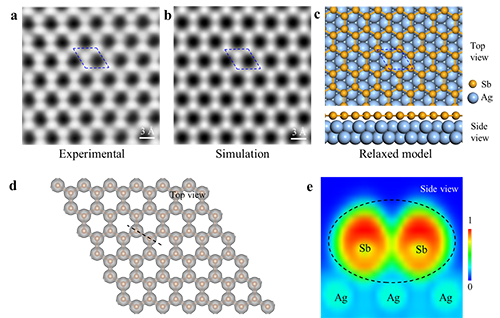Modification of structure and property realized in a new honeycomb analogue of graphene: FLAT antimonene monolayer
Date:28-12-2018 Print
Antimonene, a new discovered graphene-like 2D material, has been predicted to have excellent intrinsic optoelectronic properties and shows promise for applications in electronic MOSFET and photoelectric devices. Currently, the preparation of high quality antimonene in experiments is seldom reported, and further realization of its structure and property modification is very difficult.
Prof. Hongjun Gao’s research group from Institute of Physics, Chinese Academy of Sciences has been focusing on the fabrication, properties and potential applications of novel 2D atomic crystals in the past few years. Last year, they reported the epitaxial growth of monolayer antimonene on a PdTe2 substrate by molecular beam epitaxy. The morphology and configuration of epitaxial monolayer antimonene at atomic scale for the first time has been determined by low energy electron diffraction (LEED) and scanning tunneling microscope (STM). This work provided a method to produce high quality monolayer antimonene with a large bandgap and high chemical stability (Adv. Mater. 29, 1605407 (2017)).
Recently, researchers form the same group realized the modification of the structure and property of antimonene. They report that a uniform and single-crystalline flat antimonene monolayer without atomic wrinkles, as a new honeycomb analogue of graphene monolayer, is epitaxially grown on a Ag(111) substrate. The stains arise from the lattice mismatch between the antimonene and Ag(111) substrate lead to the formation of flat and stretched honeycomb structure of as-grown antimonene, realizing the structure modification of this 2D material. Directional bonding between adjacent Sb atoms and weak antimonene-substrate interaction are confirmed. Further calculations reveal that, this flat antimonene monolayer, which inhibits hybridization between in-plane and out-of-plane orbitals, is endowed with the quantum spin Hall effect, showing topologically nontrivial states. The realization and investigation of flat antimonene honeycombs extends the scope of two-dimensional atomically-thick structures and provides a promising way to tune topological properties for future applications.
This study entitled “Epitaxial Growth of Flat Antimonene Monolayer: A New Honeycomb Analogue of Graphene” was published on Nano Letters.
The work was mainly supported by the National Science Foundation, the Ministry of Science and Technology of China and Chinese Academy of Sciences.
 |
| Fig.1 Atomic structures and hybridized orbitals of the buckled and flat honeycombs of antimony. (Image by Institute of Physics) |
 |
| Fig.2 Schematic of fabrication process, LEED and STM images of flat antimonene monolayer on Ag(111). (Image by Institute of Physics) |
 |
| Fig.3 Atomic-resolution STM image, simulation STM and ELF calculations of monolayer antimonene. (Image by Institute of Physics) |
 |
| Fig.4 XPS measurements before and after the growth of flat antimonene monolayer on Ag(111). (Image by Institute of Physics) |
Contact:
Institute of Physics
GAO Hongjun
Email:hjgao@iphy.ac.cn
Key word:
Antimonene, two-dimensional materials, flat honeycomb lattice, epitaxial growth, STM;
Abstract:
The epitaxial growth of atomically thin flat honeycomb monolayer of group-V element antimony on a Ag(111) substrate is realized. Combined study of experiments and theoretical calculations verify the formation of a uniform and single-crystalline antimonene monolayer without atomic wrinkles, as a new honeycomb analogue of graphene monolayer. Directional bonding between adjacent Sb atoms and weak antimonene-substrate interaction are confirmed. The realization and investigation of flat antimonene honeycombs extends the scope of two-dimensional atomically-thick structures and provides a promising way to tune topological properties for future technological applications.


